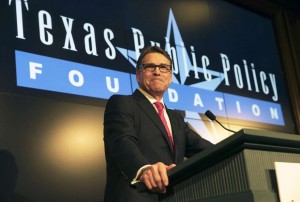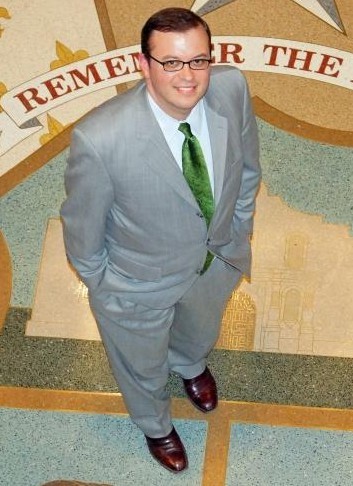
Former Gov. Rick Perry speaking at TPPF, a group which said he signed a budget in 2013 that increased spending by nearly 30 percent.
Note: This story originally appeared in The Quorum Report in 2014 after the Texas Public Policy Foundation dramatically revised its analysis of the budget passed by the Legislature in 2013. The information here is worth considering after TPPF this week released its “Conservative Texas Budget.”
Bottom line: Once the GOP primaries were concluded in 2014, the “non-partisan think tank” had a more positive view of the way lawmakers spent your tax dollars. In this year’s primary, some TPPF board members led by Vice Chairman Tim Dunn took their activism in a new direction, spending millions against Texas House Republicans who are members of the governing coalition.
Here is the story from 2014 about TPPF’s analysis of the Texas budget:
The conservative think tank in Austin where Midland oilman Tim Dunn is Vice Chairman of the board on Tuesday released a report saying that Texas state government spending saw a 9 percent increase over the previous biennium.
In their new report, which you can see here, the Texas Public Policy Foundation said their analysts looked at the finished budget and did comparisons going back to 2004. The 9 percent figure is, of course, far less than their previous estimate of as much as a 26 percent increase in state spending that was splashed on the editorial page of the Wall Street Journal under the headline “Texas Goes Sacramento” and was repeated ad nauseam by Tea Party candidates running against establishment Republicans in the recent primaries and runoffs.
Sen. Dan Patrick used that headline in ads like this one as he successfully challenged Lt. Gov. David Dewhurst to be Republican nominee to preside over the Senate.
One year ago, the Journal used the numbers from TPPF to write this:
“The danger is that Texas will repeat the fiscal mistake that California has made repeatedly: spend during the glory days and, once the economy slows, raise taxes to cover the deficit. The Texas oil patch is riding high on $95 a barrel oil and a doubling in production in four years. But Texans shouldn’t forget the lesson of the 1980s and late 1990s that oil prices are volatile and a decline can be painful and prolonged.
Mr. Perry traveled on a business recruiting mission to California in February and poked fun at the tax-spend-and-borrow cycle in Sacramento. He can fix the reckless Texas budget by vetoing all or most of it and insisting on deeper business tax cuts. He should not want people to start comparing him unfavorably to Jerry Brown.”
In a thoughtful rebuttal at the time, Texas Monthly’s Erica Grieder wrote:
“It is probably fair to say that the state tends to spend about as much as it can, but that’s because “as much as it can” is bound to be “not that much.” And Texans are generally fine with this. Evidence: They keep voting for fiscal conservatives, and have done for most of the state’s history (regardless of whether those conservatives were typed as Ds or Rs). Further evidence: the voters are, in fact, the people who keep authorizing these spending restrictions on themselves via constitutional amendments.
In other words, although the budget currently awaiting Governor Perry’s signature looks dramatically bigger than the previous one, it doesn’t mean that Texas has abruptly abandoned its longstanding tradition of fiscal responsibility. If anything the opposite is true.”
Gov. Perry did not veto that budget. In fact, Perry said “I’m not sure that those who are making that criticism have a really good handle on the Texas budget process.” Spending grew by less than the rate of inflation and population growth, Perry said, which Politifact Texas rated as a “Mostly True” statement.
TPPF’s Vice President of Policy Chuck DeVore on Tuesday said the numbers released previously were comparing money appropriated in each session and their goal was to encourage lawmakers not to spend it all.
It was made clear that the numbers that helped the WSJ say the budget had increased by 26 percent were found by looking at appropriations and authorizations, Devore said. The new numbers come from looking at the finished budget, he said. “There is zero inconsistency at all,” DeVore said. “None.”
DeVore also predicted that the 2015 session will see an early vote to bust the budget limit because of spending in the last session. “Folks may have a different perspective of last session’s spending when Medicaid under funding forces a budget cap vote,” he said.
Copyright June 29, 2016, Harvey Kronberg, www.quorumreport.com, All rights are reserved. Reprinted with permission.

